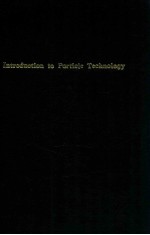图书介绍
Introduction to particle technologyPDF|Epub|txt|kindle电子书版本网盘下载

- Rhodes;M. J. 著
- 出版社: John Wiley
- ISBN:0471984833
- 出版时间:1998
- 标注页数:320页
- 文件大小:41MB
- 文件页数:334页
- 主题词:
PDF下载
下载说明
Introduction to particle technologyPDF格式电子书版下载
下载的文件为RAR压缩包。需要使用解压软件进行解压得到PDF格式图书。建议使用BT下载工具Free Download Manager进行下载,简称FDM(免费,没有广告,支持多平台)。本站资源全部打包为BT种子。所以需要使用专业的BT下载软件进行下载。如BitComet qBittorrent uTorrent等BT下载工具。迅雷目前由于本站不是热门资源。不推荐使用!后期资源热门了。安装了迅雷也可以迅雷进行下载!
(文件页数 要大于 标注页数,上中下等多册电子书除外)
注意:本站所有压缩包均有解压码: 点击下载压缩包解压工具
图书目录
1 Single Particles in a Fluid1
1.1 Motion of Solid Particles in a Fluid1
1.2 Particles Falling Under Gravity Through a Fluid3
1.3 Non-spherical Particles5
1.4 Effect of Boundaries on Terminal Velocity5
1.5 Further Reading7
1.6 Worked Examples7
Exercises17
2 Multiple Particle Systems19
2.1 Settling of a Suspension of Particles19
2.2 Batch Settling21
2.2.1 Settling Flux as a Function of Suspension Concentration21
2.2.2 Sharp Interfaces in Sedimentation23
2.2.3 The Batch Settling Test24
2.2.4 Relationship between the Height-Time Curve and the Flux Plot26
2.3 Continuous Settling29
2.3.1 Settling of a Suspension in a Flowing Fluid29
2.3.2 A Real Thickener(with Upflow and Downflow Sections)31
2.3.3 Critically Loading Thickener32
2.3.4 Underloaded Thickener33
2.3.5 Overloaded Thickener33
2.3.6 Alternative Form of Total Flux Point34
2.4 Worked examples35
Exercises47
3 Particle Size Analysis55
3.1 Introduction55
3.2 Describing the Size of a Single Particle55
3.3 Description of Populations of Particles58
3.4 Conversion Between Distributions60
3.5 Describing the Population by a Single Number60
3.6 Equivalence of Means62
3.7 Common Methods of Displaying Size Distributions64
3.7.1 Arithmetic-normal Distributions64
3.7.2 Log-normal Distribution65
3.8 Methods of Particle Size Measurement66
3.8.1 Sieving66
3.8.2 Microscopy66
3.8.3 Sedimentation66
3.8.4 Permeametry68
3.8.5 Electrozone Sensing68
3.8.6 Laser Diffraction69
3.9 Sampling70
3.10 Worked Examples70
Exercises79
4 Fluid Flow Through a Packed Bed of Particles81
4.1 Pressure Drop-flow Relationship81
4.1.1 Laminar Flow81
4.1.2 Turbulent Flow83
4.1.3 General Equation for Turbulent and Laminar Flow83
4.1.4 Non-spherical Particles84
4.2 Filtration85
4.2.1 Introduction85
4.2.2 Incompressible Cake85
4.2.3 Including the Resistance of the Filter Medium86
4.2.4 Washing the Cake87
4.2.5 Compressible Cake88
4.3 Further Reading89
4.4 Worked Examples89
Exercises93
5 Fluidization97
5.1 Fundamentals97
5.2 Relevant Powder and Particle Properties100
5.3 Bubbling and Non-bubbling Fluidization101
5.4 Classification of Powders102
5.5 Expansion of a Fluidized Bed107
5.5.1 Non-bubbling Fluidization107
5.5.2 Bubbling Fluidization108
5.6 Entrainment110
5.7 Heat Transfer in Fluidized Beds115
5.7.1 Gas-Particle Heat Transfer115
5.7.2 Bed-Surface Heat Transfer116
5.8 Application of Fluidized Beds119
5.8.1 Physical Processes119
5.8.2 Chemical Processes120
5.9 A Simple Model for the Bubbling Fluidized Bed Reactor122
5.10 Some Practical Considerations127
5.10.1 Gas Distributor127
5.10.2 Loss of Fluidizing Gas127
5.10.3 Erosion128
5.10.4 Loss of Fines128
5.10.5 Cyclones128
5.10.6 Solids Feeders129
5.11 Worked Examples129
Exercises134
6 Pneumatic Transport and Standpipes139
6.1 Pneumatic Transport139
6.1.1 Dilute Phase and Dense Phase Transport140
6.1.2 The Choking Velocity in Vertical Transport140
6.1.3 The Saltation Velocity in Horizontal Transport142
6.1.4 Fundamentals143
6.1.5 Design for Dilute Phase Transport147
6.1.6 Dense Phase Transport152
6.1.7 Matching the System to the Powder158
6.2 Standpipes159
6.2.1 Standpipes in Packed flow160
6.2.2 Standpipes in Fluidized Bed Flow160
6.2.3 Pressure Balances During Standpipe Operation163
6.3 Further Reading166
6.4 Worked Examples166
Exercises172
7 Separation of Particles from a Gas:Gas Cyclones175
7.1 Gas Cyclones-description176
7.2 Flow Characteristics177
7.3 Efficiency of Separation177
7.3.1 Total Efficiency and Grade Efficiency177
7.3.2 Simple Theoretical Analysis for the Gas Cyclone Separator178
7.3.3 Cyclones Grade Efficiency in Practice181
7.4 Scale-up of Cyclones181
7.5 Range of Operation182
7.6 Some Practical Design and Operation Details185
7.6.1 Effect of Dust Loading on Efficiency185
7.6.2 Cyclone Types185
7.6.3 Abrasion185
7.6.4 Attrition of Solids186
7.6.5 Blockages186
7.6.6 Discharge Hoppers and Diplegs186
7.6.7 Cyclones in Series187
7.6.8 Cyclones in Parallel187
7.7 Worked Examples187
Exercises191
8 Storage and Flow of Powders-Hopper Design193
8.1 Introduction193
8.2 Mass Flow and Core Flow193
8.3 The Design Philosophy196
8.3.1 Flow-No Flow Criterion197
8.3.2 The Hopper Flow factor ff197
8.3.3 Unconfined Yield Stress,σy197
8.3.4 Powder Flow Function198
8.3.5 Critical Conditions for Flow198
8.3.6 Critical Outlet Dimension199
8.3.7 Summary200
8.4 Shear Cell Tests200
8.5 Analysis of shear cell test results202
8.5.1 Mohr’s Circle-in Brief202
8.5.2 Application of Mohr’s Circle to Analysis of the Yield Locus202
8.5.3 Determination of σy and σc203
8.5.4 Determination of δ from Shear Cell Tests204
8.5.5 The Kinematic Angle of Friction Between Powder and Hopper Wall205
8.5.6 Determination of the Hopper Flow Factor206
8.6 Summary of Design Procedure209
8.7 Discharge Aids210
8.8 Pressure on the Base of a Tall Cylindrical Bin210
8.9 Mass Flow Rates213
8.10 Conclusions213
8.11 Worked Examples214
Exercises217
9 Mixing and Segregation223
9.1 Introduction223
9.2 Types of Mixture223
9.3 Segregation224
9.3.1 Causes and Consequences of Segregation224
9.3.2 Mechanisms of Segregation225
9.4 Reduction of Segregation229
9.5 Equipment of Particulate Mixing230
9.5.1 Mechanisms of Mixing230
9.5.2 Types of Mixer230
9.6 Assessing the Mixture232
9.6.1 Quality of a Mixture232
9.6.2 Sampling232
9.6.3 Statistics Relevant to Mixing232
9.7 Worked Examples235
Exercises239
10 Particle Size Reduction241
10.1 Introduction241
10.2 Particle Fracture Mechanisms241
10.3 Model Predicting Energy Requirement and Product Size Distribution245
10.3.1 Energy Requirement245
10.3.2 Prediction of the Product Size Distribution249
10.4 Types of Comminution Equipment250
10.4.1 Factors Affecting Choice of Machine250
10.4.2 Stressing Mechanisms251
10.4.3 Particle Size256
10.4.4 Material Properties257
10.4.5 Carrier medium258
10.4.6 Mode of operation258
10.4.7 Combination with Other Operations258
10.4.8 Types of Milling Circuit259
10.5 Worked Examples260
Exercises263
11 Size Enlargement267
11.1 Introduction267
11.2 Interparticle Forces268
11.2.1 Van der Waals Forces268
11.2.2 Forces due to Absorbed Liquid Layers268
11.2.3 Forces due to Liquid Bridges268
11.2.4 Electrostatic Forces269
11.2.5 Solid Bridges270
11.2.6 Comparison and Interaction between Forces270
11.3 Granulation271
11.3.1 Introduction271
11.3.2 Granulations Rate Processes271
11.3.3 Simulation of the Granulation Process275
11.3.4 Granulation Equipment279
12 Fire and Explosion Hazards of Fine Powders283
12.1 Introduction283
12.2 Combustion Fundamentals284
12.2.1 Flames284
12.2.2 Explosions and Detonations284
12.2.3 Ignition,Ignition Energy,Ignition Temperature-a Simple Analysis284
12.2.4 Flammability Limits287
12.3 Combustion in Dust Clouds289
12.3.1 Fundamentals Specific to Dust Cloud Explosions289
12.3.2 Characteristics of Dust Explosions289
12.3.3 Apparatus for Determination of Dust Explosion Characteristics290
12.3.4 Application of the Test Results292
12.4 Control of the Hazard293
12.4.1 Introduction293
12.4.2 Ignition Sources294
12.4.3 Venting295
12.4.4 Suppression296
12.4.5 Inerting296
12.4.6 Minimise Dust Cloud Formation296
12.4.7 Containment296
12.5 Worked Examples297
Exercises299
Notation301
References309
Index315